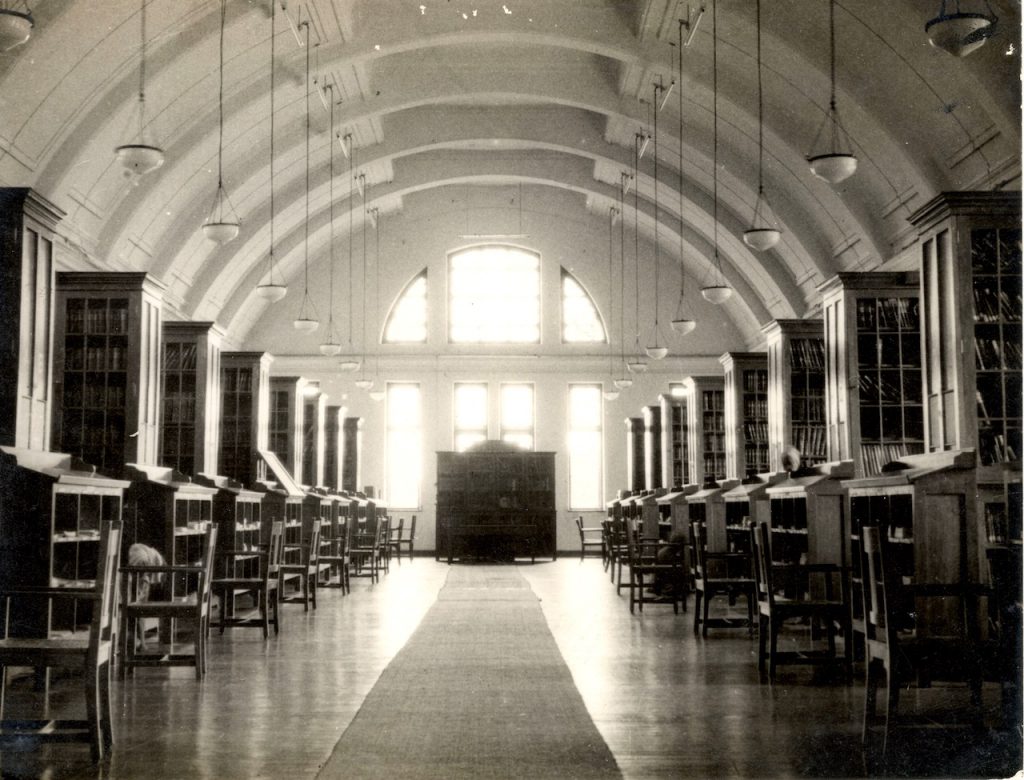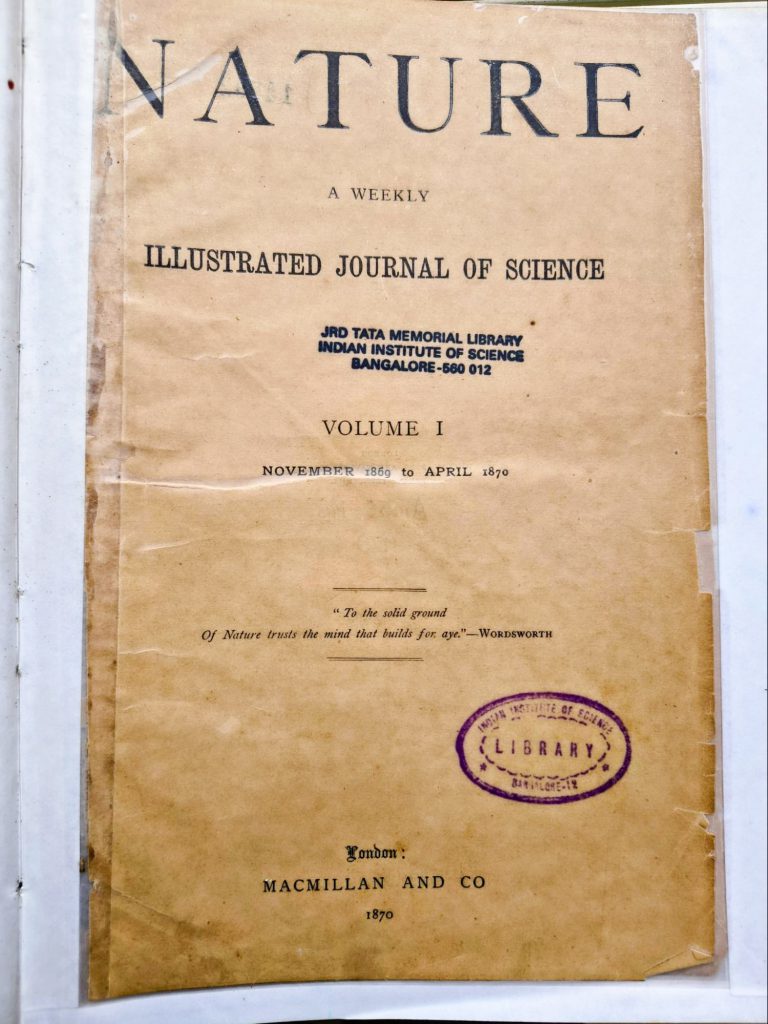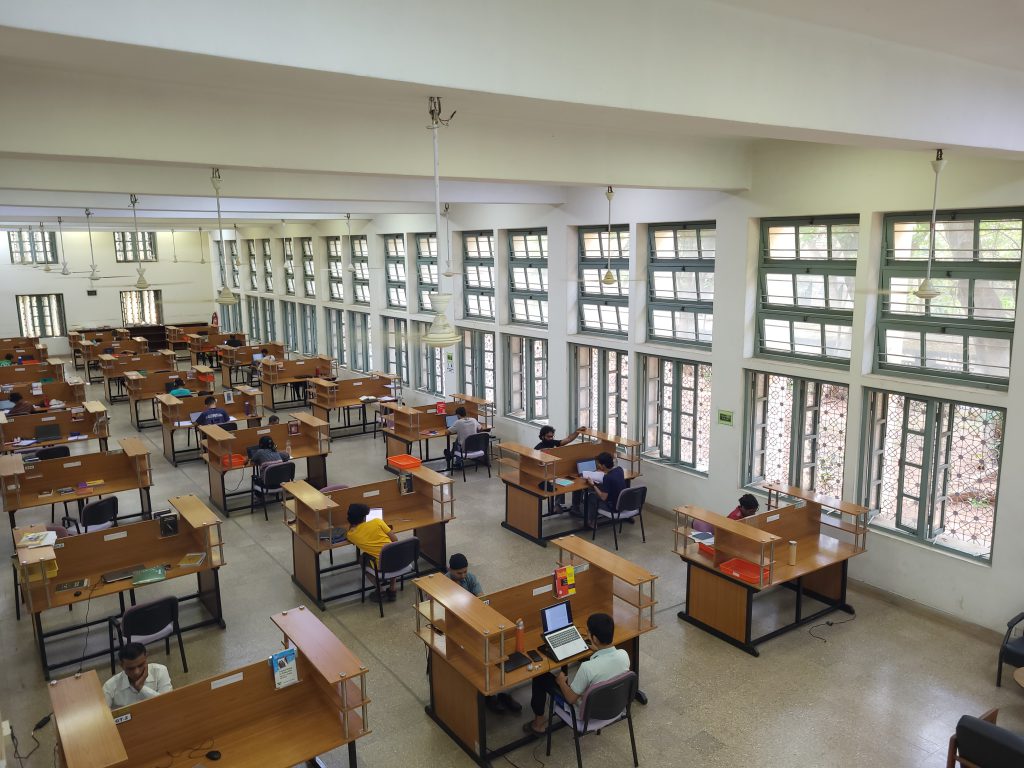The enduring legacy of the JRD Tata Memorial Library

In the late hours of the night, the bustling and lively IISc campus halts to a slight murmur. The streets are deserted; the silence is broken only by the slow pacing of the night guards and dogs barking at nothing in particular. In this dark tranquillity, one building catches the eye: a massive rectangular structure, not too far away from IISc’s Main Building. Beams of light pour out of small windows, giving its white walls a pleasant glow.
Within these walls, we can witness quiet but intense struggles. In the spacious and welcoming interior, students sit at their work stations with eyebrows furrowed, deep in thought as they ponder their assignments, project submissions, and research questions. Clacking of keyboards and the tapping of anxious feet fills the compelling silence, which has an oddly relaxing effect on the students as they burn the midnight oil. Occasionally, the odd student rustles through the bookshelves, their fingers searching for the correct reference before they head back to their workstation, deep in thought. This is an average night at the JRD Tata Memorial Library.
Over the years, the library has grown alongside the Institute as a repository of knowledge

Over the years, the library has grown alongside the Institute as a repository of knowledge. It started functioning in 1911, just two years after IISc was established. At that time, it was housed on the first floor of the Main Building, which was then also called the Library Block. During the Institute’s Golden Jubilee celebrations in 1959, plans were announced to construct a separate library building. Officially inaugurated six years later, the building is spread across a massive 54,000 square feet and continues to house the library to this day. In 1995, it was renamed from the Golden Jubilee Library to the JRD Tata Memorial Library. Following a grant from the Tata Foundation, the Digital Library Centre and the Library Annexe (now repurposed into the Faculty Club) were inaugurated in 1998.
When the library started, it had a collection of around 6,000 books, journals and articles from domestic and international publishers, catering to a tiny population of just 24 students. It has since grown to serve the needs of more than 5,000 students and 500 faculty members. It has a physical collection of more than four lakh volumes of books and journals, at an estimated valuation of hundreds of crores.
As with all academic libraries, the primary mission of the JRD Tata Memorial Library has been to curate a quality collection of books and scholarly journals to support teaching, learning, and research programmes of the Institute. In the early days, subscribed print journals from various publishers across the world were shipped to the Institute. Later, the journal articles would arrive in the more compact magnetic tape format, and could be printed into a physical format as required. With the advent of new technologies, this has now been superseded by online journals and databases.
To create a bank of scientific information, the library prioritised the purchase of back volumes, which are older editions of journals that are otherwise inaccessible. A lot of effort has been made over the years to fill in these gaps. As a result, the library has an archival collection starting from the very first editions of various high-impact journals published by Springer Nature, American Chemical Society, and more. “In 2018, we were approached by Springer Nature, who wanted permission to scan the physical copy of the Volume 1, Issue 1 edition of one of their own journals,” recalls Suresh Balutagi, the current Deputy Librarian.

But as the collection grew, maintenance became a chore. By 1980, it had grown to around two lakh books and journals. “Organising the entire collection was a major task. All of us, including the librarian, had to work day and night for a whole month each time the journals would arrive,” explains Puttabasavaiah, who worked as the Deputy Librarian until 2017.
Earlier, current bound volumes were organised subject wise. However, a majority of requests from users were based on the title of the journal. Therefore, it was decided to organise the entire journal collection alphabetically by title. This was a huge task and most of the library staff including the then librarian worked round the clock for more than a month. Similar work was also carried out in segregating pre-1970 bound volumes of journals. In the case of books, a separate compact area was created to stack passive collections.
Going digital
Digitisation first came about in the late 1980s, when a computer centre and LAN (Local Area Network) for the library were set up. This effort was spearheaded by the National Centre for Science Information (NCSI), which was established in 1983 to provide electronic information services to researchers. The NCSI operated from two rooms within the library building.
In the mid-1990s, the colossal effort of digitisation began. For cataloguing purposes, the library chose the commercial library management software LibSys. Then began the gruelling task of entering the bibliographic details of each item from the library catalogue into the LibSys software. Fortunately, bibliographic data for about 20,000 books which were added in recent years were already available in dBase (a database management system). This data was converted to the ASCII format and later to ISO2709 so that it could be ported to the LibSys database. All this was done in a single day, and the complete bibliographic data was made available for online access, search, and retrieval. As online access was through Telnet, a remote access network protocol widely used at the time, it was very slow and there were complaints from users. To overcome this, all the library data was again ported onto a system called Managing Gigabytes (MG) and access was made available on the web for search and retrieval. This was possible because of help from NCSI.
‘At that point in time, no other library in the country was doing this kind of [digitisation] work’
Later, the libraries of the Raman Research Institute (RRI) and the National Aerospace Laboratories (NAL), which were also using LibSys, joined this effort and shared their bibliographic data. Thus, all three library collections were made available online. “At that point in time, no other library in the country was doing this kind of work,” says Puttabasavaiah, who was employed at the NCSI during this process.
In addition to scanning and uploading the entire collection, an online user ID system for all students and staff had to be created, to have an online record of lending and borrowing. The whole process of digitisation was finally completed on 3 March 1999.
This was a major step in the evolution of the library. Several physical services have since been replaced thanks to the convenience of their digital counterparts, like reference queries from researchers that used to be handled by the library staff earlier. Among them was overnight lending, a feature where you could borrow a book at night and then return it in the early hours of the morning. This was an immensely popular service when introduced. “We used to get around 300 overnight lending requests per day in the 1970s and 80s,” Puttabasavaiah recalls.
There was also a tradition for the Institute Director to visit the library every Thursday to check on the new arrivals. This practice carried on until the tenure of P Balaram, who retired as the Director of IISc in 2014. The photocopy service provided by the library, which would send thousands of pages of high-end journals and papers to researchers and departments around the country, was discontinued, and the cancellation of print subscriptions meant that binding service for journal volumes has also all but gone away.
The biggest change was the reduction of staff working on the maintenance and upkeep of the library. Starting from around 90 permanent employees in the 1930s, the number has come down to 12 in 2025. This has reflected a general trend within IISc, according to Uma Jagannath, who was the Deputy Librarian until 2007. “In those days, the Institute had a lot more staff members. Employees’ associations were also very active and had regular meetings,” she remembers.
Money matters
Having an extensive and good-quality collection of journals is a necessity for any established academic library. But over time, the process of acquiring new journals has become much harder because the price is in the hands of a small oligarchy of for-profit publishers. For example, article processing fees for a single journal can go up to thousands of US dollars, and can be increased by around 10% each year. As such, the library staff has to try different tactics to keep the subscription budget under control.
In earlier years, the library obtained some journals in exchange for access to the institute’s in-house production
In earlier years, the library obtained some journals in exchange for access to the Institute’s in-house production, The Journal of the Indian Institute of Science, which has been maintained by the library since 1914.
One of the other tactics used is to seek discounts in exchange for making subscriptions through intermediary subscription agencies. Another is to form consortia of multiple institutes and jointly negotiate for bulk discounts with a publisher. The largest of these consortia is the eSS (e-Shodh Sindhu) managed by the Government of India with more than 200 member universities. It allows for greater exchange of information between member libraries, with the restriction being that they can only be used to get access to services that are beneficial to the majority of the members.
Given the rising subscription costs, a survey was carried out in 2006 to identify which foreign journals were of least value to the faculty members at IISc. It was decided to retain journals with a high impact factor, journals in which articles by IISc faculty members had published, and journals where faculty publications were cited. Based on this, a list of journals for discontinuance was generated and circulated amongst the faculty for their feedback, after which a final list was created.
“We decided to cut access to journals without mercy. In the end, almost half of them were cut down,” shares Puttabasavaiah. In recent years, the library has had to enter into tough negotiations with publishers and make hard choices regarding which services to continue. Despite these efforts, the current annual budget for journal subscriptions has surpassed Rs 20 crore.
A researcher’s best friend
Starting from modest beginnings, decades of coordinated effort have led to the JRD Tata Memorial Library becoming one of the largest scientific and technical libraries in India. It has given continuous assistance for research and publishing to all departments at IISc and has played a notable part in the scientific achievements of the Institute. It maintains ePrints and eBooks, which are online repositories of the research output of IISc in digital format. Since the merging of NCSI with the library, it has also maintained a number of digital repositories, including collections of theses and dissertations, and a list of faculty profiles.
Even those IISc residents who do not visit the library regularly utilise the services it provides. “Between looking at journal articles, reading eBooks and accessing MathSciNet (a comprehensive database of mathematical literature), I use services provided by the library all the time,” says Swarnendu Sil, Assistant Professor at the Department of Mathematics.
The library also allows restricted access to its collection to any researcher within India
In addition to this, the library also allows any researcher within India to access its collection; one just needs to apply for a library card to get restricted access, making it an invaluable national resource. It has recently joined the One Nation One Subscription (ONOS) initiative by the Government of India, which seeks to provide nationwide access to thousands of journals across 30 different publishers.

There are still many challenges that the library faces daily. Although digitisation has made many processes easier, keeping the digital architecture up to date (for example, moving various digital services to cloud computing) is an extremely complicated and time-consuming task. Then there is the matter of rising prices of journal subscriptions. Despite these challenges, it has continued to expand and has become an essential part of the research workflow in IISc, thanks to a long chain of efforts by successive generations of people.
The library is still constantly looking to improve based on user needs and feedback. Just a few years ago, the operating hours were increased to 24 hours a day, except Sundays, to help students who need a place to study at night. Though so much of the functioning of the library has moved online, the building still attracts many students. “I have spent so much time in the library that it feels like a second home,” says Ekta, fourth year BS (Research) student at IISc. “And since it is now open at night too, I can study without worrying about when I will be kicked out.”
Aviral Sood is a fourth year BSc (Research) student at IISc, and a science writing intern at the Office of Communications
(Edited by Sandeep Menon, Abinaya Kalyanasundaram)




